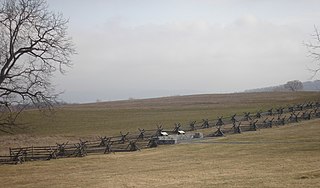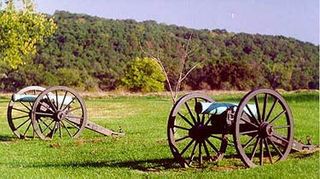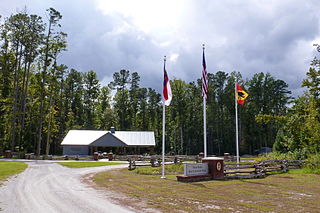Related Research Articles

The Battle of Brice's Cross Roads was fought on Friday, June 10, 1864, near Baldwyn, Mississippi, then part of the Confederate States of America. A Federal expedition from Memphis, Tennessee, of 4,800 infantry and 3,300 cavalry, under the command of Brigadier-General Samuel D. Sturgis, was defeated by a Confederate force of 3,500 cavalry under the command of Major-General Nathan B. Forrest. The battle was a victory for the Confederates. Forrest inflicted heavy casualties on the Federal force and captured more than 1,600 prisoners of war, 18 artillery pieces, and wagons loaded with supplies. Once Sturgis reached Memphis, he asked to be relieved of his command.

O. James "Jim" Lighthizer is an American lawyer, politician, and the president of the American Battlefield Trust non-profit battlefield preservation organization.

The Battle of Mine Run, also known as Payne's Farm, or New Hope Church, or the Mine Run campaign, was conducted in Orange County, Virginia, in the American Civil War.

The Battle of Champion Hill of May 16, 1863, was the pivotal battle in the Vicksburg Campaign of the American Civil War (1861–1865). Union Army commander Maj. Gen. Ulysses S. Grant and the Army of the Tennessee pursued the retreating Confederate States Army under Lt. Gen. John C. Pemberton and defeated it twenty miles to the east of Vicksburg, Mississippi, leading inevitably to the Siege of Vicksburg and surrender. The battle is also known as Baker's Creek.
The American Battlefield Trust is a charitable organization whose primary focus is in the preservation of battlefields of the American Civil War, the Revolutionary War and the War of 1812 through acquisition of battlefield land. The American Battlefield Trust was formerly known as the Civil War Trust. On May 8, 2018, the organization announced the creation of the American Battlefield Trust as the umbrella organization for two divisions, the Civil War Trust and the Revolutionary War Trust, which was formerly known as "Campaign 1776." The name American Battlefield Trust reflects the organization's expanded mission, announced in 2014, of saving land at battlefields of the Revolutionary War and the War of 1812 as well as the American Civil War The American Battlefield Trust also promotes educational programs and heritage tourism initiatives to inform the public about these three conflicts and their significance in American history. On May 31, 2018, the Trust announced that with the acquisition of 13 acres at the Cedar Creek battlefield in the Shenandoah Valley of Virginia, it had reached the milestone of 50,000 acres of battlefield land acquired and preserved. Since 1988, the Trust and its federal, state and local partners have preserved land in 24 states at more than 130 battlefields of the Civil War, the Revolutionary War and the War of 1812. More than 10,000 of the acres have been acquired and preserved since 2014.

Antietam National Battlefield is a National Park Service-protected area along Antietam Creek in Sharpsburg, Washington County, northwestern Maryland. It commemorates the American Civil War Battle of Antietam that occurred on September 17, 1862.

Wilson's Creek National Battlefield, located near Republic, Missouri, preserves the site of the Battle of Wilson's Creek. Fought on August 10, 1861, the battle was the first major American Civil War engagement west of the Mississippi River. In the battle, a Confederate army commanded by Benjamin McCulloch and Sterling Price defeated a smaller Union army commanded by Nathaniel Lyon. However, the Confederates were unable to hold much of Missouri, and a Confederate defeat at the Battle of Pea Ridge effectively solidified Union control of the state. Major features include a five-mile automobile tour loop, the restored 1852 Ray House, and "Bloody Hill," the site of the final stage of the battle. The site is located near Republic in southwestern Missouri just southwest of the city of Springfield. It has been a unit of the National Park Service since 1960, and was listed on the National Register of Historic Places in 1966.

The Battle of Rocky Face Ridge was fought May 7–13, 1864, in Whitfield County, Georgia, during the Atlanta Campaign of the American Civil War. The Union army was led by Maj. Gen. William Tecumseh Sherman and the Confederate army by Gen. Joseph E. Johnston. Confederates were forced to evacuate their strong position due to a Union flanking movement.

Cedar Creek and Belle Grove National Historical Park became the 388th unit of the United States National Park Service when it was authorized on December 19, 2002. The National Historical Park was created to protect several historically significant locations in the Shenandoah Valley of Northern Virginia, notably the site of the American Civil War Battle of Cedar Creek and the Belle Grove Plantation.

Sackets Harbor Battlefield State Historic Site is a historically important location in Jefferson County, New York, United States. The historic site is south of the Village of Sackets Harbor, bordering Lake Ontario in the Town of Hounsfield. Two battles were fought near this location during the War of 1812. Some 3,000 men worked at the shipyard building warships, and the village was fortified and garrisoned with thousands of troops.
The American Battlefield Protection Program (ABPP) is a United States federal government program created by the Secretary of the Interior in 1991, with the aim of preserving historic battlefields in the United States. In 1996, Congress signed into law the American Battlefield Protection Act, which officially authorized the ABPP. The program operates under the American Battlefield Protection Program Authorization as of 2009.

Perryville Battlefield State Historic Site is a 745-acre (3.01 km2) park near Perryville in Boyle County, Kentucky. The park continues to expand with purchases of parcels by the Office of Kentucky Nature Preserves' Kentucky Heritage Land Conservation Fund and the American Battlefield Trust. An interpretive museum is located near the site where many Confederate soldiers killed in the Battle of Perryville were buried. Additionally, monuments, interpretive signage, and cannons mark notable events that occurred during the battle. The site became part of the Kentucky State Park System in 1936.

The Princeton Battlefield in Princeton, Mercer County, New Jersey, United States, is where American and British troops fought each other on January 3, 1777 in the Battle of Princeton during the American Revolutionary War. The battle ended when the British soldiers in Nassau Hall surrendered. This success, following those at the Battle of Trenton on December 26, 1776 and the Battle of the Assunpink Creek the day before, helped improve American morale.

Horse Island Light, also known as Sackets Harbor Light, is located on Horse Island in Sackets Harbor, Jefferson County in New York on Lake Ontario. In July 2017 the 24-acre island was acquired for preservation by the Civil War Trust, aided by a grant from the National Park Service. This was the first grant in the United States made for a War of 1812 site under the NPS battlefield grants program.

In March 2006, the Civil War Preservation Trust (CWPT) - now the Civil War Trust - announced the beginning of a $12 million national campaign to preserve the historic Slaughter Pen Farm, a key part of the Fredericksburg battlefield. The 205-acre (0.83 km2) farm, known locally as the Pierson Tract, was the scene of bloody struggle on December 13, 1862. Over this ground Federal troops under Maj. Gen. George Meade and Brig. Gen. John Gibbon launched their assault against Lt. Gen. Thomas "Stonewall" Jackson's Confederates holding the southern portion of the Army of Northern Virginia's line at Fredericksburg. Despite suffering enormous casualties the Federal troops under Meade were able to temporarily penetrate the Confederate line and for a time represented the North's best chance of winning the Battle of Fredericksburg. The fighting on this southern portion of the battlefield, later named the Slaughter Pen, produced 5,000 casualties and five Medal of Honor winners.

Pamplin Historical Park is a 424-acre private sector historical park located near Petersburg, Virginia. The park preserves open space near Richmond, Virginia in Dinwiddie County, Virginia and serves the dual use of preserving a significant fragment of the Petersburg Breakthrough Battlefield, a National Historic Landmark, and key components of the Third Battle of Petersburg. The park also provides a footprint location for the National Museum of the Civil War Soldier, which is located within the park.

New Bern Battlefield Site is a historic site of the American Civil War Battle of New Bern located near New Bern, Craven County, North Carolina. The battle was fought on 14 March 1862. The New Bern Battlefield Site consists of two discontiguous sites.

Averasboro Battlefield Historic District is a national historic district located near Erwin, Harnett County, North Carolina. It encompasses four contributing buildings, three contributing sites, three contributing structures, and one contributing object on the battlefield associated with the American Civil War Battle of Averasboro of March 15–16, 1865. They include the separately listed Oak Grove and Lebanon plantations, along with a Commemorative Marker (1872), Chicora Cemetery and over 4,000 acres of rural agricultural land.

Commemoration of the American Revolution typifies the patriotic sentiment surrounding the American Revolution and the desire to preserve and honor the "Spirit of '76". As the founding story of the United States, it is covered in the schools, memorialized by a national holiday, and commemorated in innumerable monuments. Thus Independence Day is a major national holiday celebrated annually. Besides local sites such as Bunker Hill, one of the first national pilgrimages for memorial tourists was Mount Vernon, George Washington's estate, which attracted ten thousand visitors a year by the 1850s.

Allen Wilson Greene, also known as Will Greene, is an American historian, author, and retired museum director. Greene was the director of the Association for the Preservation of Civil War Sites. Later, he became director of Pamplin Historical Park and the National Museum of the Civil War Soldier in Petersburg, Virginia. He also served on the national oversight board for the Institute of Museum and Library Services Over the years, Greene has made ten appearances on C-SPAN.
References
- ↑ "Breaking News: The Civil War Trust Introduces the American Battlefield Trust" Announcement accessed May 10, 2018.
- 1 2 Hadar, Mary (July 21, 2017). "Opinion - Behind the bitter war to preserve the Civil War battlefields" . Retrieved December 18, 2017– via www.WashingtonPost.com.
- ↑ "Smithsonian Journeys Experts—A. Wilson Greene", Smithsonian Journeys, Smithsonian Institution, Washington, District of Columbia, accesses 27 March 2017.
- ↑ Lange, Chris, "A. Wilson Greene stepping down a quarter century after starting Pamplin Park", Progress-Index, Petersburg, Virginia, 9 April 2017.
- ↑ "A Good Fight: Fighting the Second Civil War". www.HistoryNet.com. Retrieved December 18, 2017.
- ↑ "National Effort Aims to Save Revolutionary Battlefields". Fredericksburg Free Lance-Star article accessed December 14, 2017.
- ↑ "Saved Land - Civil War Trust". www.CivilWar.org. Retrieved July 31, 2020.